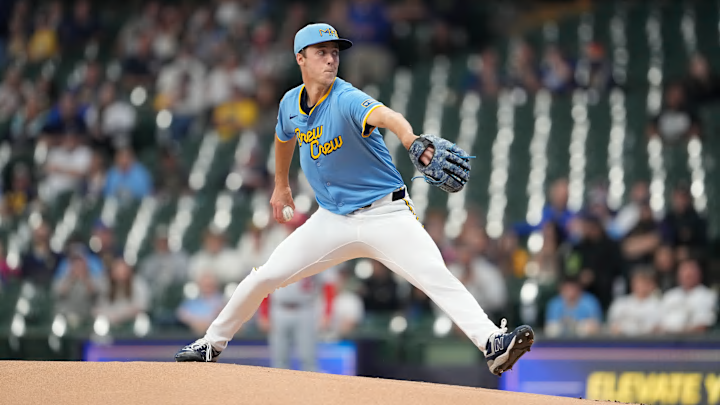The St. Louis Cardinals displayed a feeble offensive effort in their game against the Milwaukee Brewers on June 12, as the Brewers' starting pitcher sliced and diced his way through the Cardinals' lineup, hitting 102 mph with his fastball and striking out five batters through five innings while not surrendering a single hit. That pitcher, Jacob Misiorowski, was making his major league debut, and although he was removed with an injury in the sixth frame, his top-tier stuff made it clear as day that the Cardinals' draft strategy for pitchers over the past decade has been woefully out of date.
The Brewers picked Misiorowski in the second round of the 2022 draft, and his pre-draft scouting report mentioned his high-octane fastball but his difficulty reining it in for strikes as well as his likelihood of becoming a relief pitcher if he didn't find a third reliable pitch. Three years later, Misiorowski still hasn't honed his control to an average level, but it had improved in his last Triple-A stint. The Brewers also helped him develop a curveball that displays nasty break. This is what a high-ceiling pitcher looks like for a team that knows how to develop them.
The way the Cardinals draft and develop pitchers can't hold a candle to the Brewers' philosophy.
The Cardinals have taken a drastically different approach to the pitchers they've drafted. In the same draft where the Brewers selected Misiorowski, the Cardinals used their first-round pick on sidearming lefty Cooper Hjerpe, who profiled as a deceptive starter who could slot in at the back of a rotation. To this point, Hjerpe has struggled to stay healthy, pitching only 93.1 innings in his minor league career thus far and not yet ascending above Double-A.
These lower-risk arms have been a staple for the Cardinals in the first few rounds of their drafts. In 2021, the Cardinals chose Michael McGreevy with their first pick, and while McGreevy has performed well in his limited major league appearances, his upside is very limited given his middling arsenal and lack of strikeout weapons. In 2019, the Cardinals' first pick was Zack Thompson, a college pitcher who, to the Cardinals' credit, had displayed some swing-and-miss stuff in college but who still projected as a back-of-the-rotation piece at his peak. This goes back even farther, with first-round picks such as Dakota Hudson and Jake Woodford also failing to make major impacts in the big leagues.
You see the theme here. The Cardinals love choosing college pitchers who are good bets to make the major leagues but are unlikely to become stars. On the other hand, the team has attempted some big swings when drafting hitters in the first round, taking Jordan Walker in 2020 and Nolan Gorman in 2018. Both were selected out of high school and were longer-term development projects. Neither has yet panned out as hoped, but these are the types of players who have the chance to be franchise cornerstones if they are developed properly.
The Cardinals' radically different strategies in choosing pitchers early versus hitters could indicate a lack of confidence in the organization to develop pitching, forcing the Cardinals to rely on hurlers who are already somewhat polished. The team's revamped approach to pitching under Assistant General Manager Rob Cerfolio and Director of Pitching Matt Pierpont will hopefully allow the Cardinals to catch up to other teams such as Milwaukee in their ability to develop rawer but more projectable arms.
Choosing younger pitchers with more potential may appear to be too much of a die-roll for the normally risk-averse Cardinals, but it's worth noting that even if the Cardinals opt to trade these players at some point, they are likely to receive a greater haul than they would if they were trading pitchers who were safer picks. Opposing teams may believe they can unlock another level to a pitcher who has shown All-Star upside, but they may not bother with one who they believe has already developed as much as he can.
As a team that once led the pack in player development, the Cardinals might not be comfortable following the herd in the types of pitchers to target early, but the lethal stuff that Misiorowski showcased in his debut illustrated the kind of benefits that a team can reap by taking a gamble and investing in its development staff. For smaller-market teams in the middle of America that don't often land the lucrative free agents, this kind of approach is integral to remaining competitive. The Cardinals will hopefully remember Misiorowski's dominance when the draft rolls around and pick a possible building block who can begin the team's long road back to pitching relevance.
